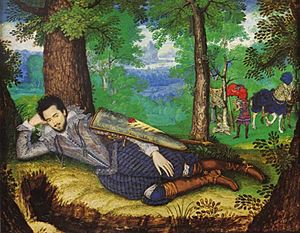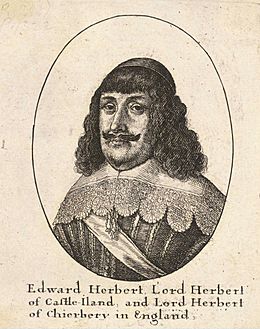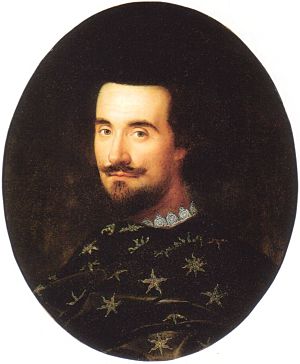Edward Herbert, 1st Baron Herbert of Cherbury facts for kids
Edward Herbert, 1st Baron Herbert of Cherbury (born March 3, 1583 – died August 5, 1648) was an important English figure. He was a soldier, a diplomat, a historian, a poet, and a philosopher. He lived during the time of the Kingdom of England.
Edward Herbert studied many languages and subjects at University College, Oxford. He started his political career in the English Parliament. He represented areas like Montgomeryshire and Merioneth.
As a soldier, he showed great bravery in the Low Countries, fighting alongside the Prince of Orange. His most active work as a diplomat was in Paris. There, he tried to arrange a marriage between Charles, Prince of Wales, and Henrietta Maria of France. This plan did not succeed.
Herbert was given an Irish noble title, Baron Herbert of Castle Island, in 1624. He received an English noble title in 1629. During the English Civil War, he chose to remain neutral. He retired to his home at Montgomery Castle.
He is best known for his ideas in philosophy. His famous book, "De Veritate," made him known as the "father of English Deism." This important book explains how to tell truth from other things like guesses or false ideas. He also wrote "De religione gentilium," which was an early book about different religions. His autobiography tells many stories about his life up to 1624.
Contents
Edward Herbert's Life Story
Growing Up and Early Career
Edward Herbert was the oldest son of Richard Herbert of Montgomery Castle. His mother was Magdalen, daughter of Sir Richard Newport. He was also the brother of the famous poet George Herbert. Edward was born in England, near Wroxeter in Shropshire.
He had private lessons before going to University College, Oxford, in May 1596. On February 28, 1599, when he was 15, he married his cousin Mary. She was 21 years old. He returned to Oxford with his wife and mother. There, he continued his studies. He learned French, Italian, and Spanish. He also learned music, riding, and fencing. He started his family during this time.
Herbert became a Member of Parliament for Montgomeryshire in 1601. When King James I became king, Edward was made a Knight of the Bath on July 24, 1603. From 1604 to 1611, he was a Member of Parliament for Merioneth. He also served as a magistrate and sheriff of Montgomeryshire in 1605.
A Brave Soldier

In 1608, Edward Herbert traveled to Paris. He became friends with the Constable de Montmorency and met King Henry IV. He also stayed with the scholar Isaac Casaubon. When he returned to England, he was very well-regarded by important people. He was friends with famous writers like Ben Jonson and John Donne.
In 1610, Herbert joined the army as a volunteer in the Low Countries. He served under the Prince of Orange, who became his close friend. Herbert showed great courage during the capture of Juliers. He even offered to fight a champion from the enemy side to end the war, but his challenge was not accepted.
He visited Spinola in the Spanish camp. He also traveled to Heidelberg and Italy. At one point, he led a group of 4,000 Huguenots from Languedoc into Piedmont. This was to help the Savoyards against Spain. However, he was imprisoned in Lyon, and the plan failed. He then returned to the Netherlands and the Prince of Orange. He arrived back in England in 1617.
Working as a Diplomat
In 1619, Edward Herbert was made the ambassador to Paris. He was involved in a case about stolen jewels belonging to Anne of Denmark. A disagreement with Charles de Luynes led to Herbert being called back to England in 1621. After de Luynes died, Herbert returned to his ambassador role in February 1622.
He was well-liked at the French court and showed good diplomatic skills. His main goals were to arrange a marriage between Charles, Prince of Wales, and Henrietta Maria of France. He also tried to get help from Louis XIII for Frederick V, Elector Palatine. He did not succeed in getting help for Frederick. He was dismissed from his post in April 1624.
Herbert returned home with many debts. He received few rewards for his work. He was given the Irish noble title of Baron Herbert of Castle Island in May 1624. In May 1629, he received the English noble title of Herbert of Cherbury.
Later Years and the Civil War
In 1632, Herbert became a member of the council of war. He was with the king in York during the Bishops' Wars with Scotland in 1639. In May 1642, Parliament imprisoned him. This was because he suggested adding words to a resolution in the House of Lords.
After this, he decided not to take part in the English Civil War. He retired to Montgomery Castle. He refused the king's request to join him in Shrewsbury, saying he was too ill.
On September 5, 1644, he gave up his castle to the Parliamentary forces. He then returned to London and was given a pension of £20 a week. In 1647, he visited Pierre Gassendi in Paris. He died in London the next summer, at age 65. He was buried in the church of St Giles in the Fields.
His Family
Lord Herbert had two sons, Richard (who lived from about 1600–1655) and Edward. Richard became the 2nd Lord Herbert of Cherbury. Richard's sons, Edward and Henry, also held the title. After them, the title ended. It was brought back in 1694 for Henry Herbert (1654–1709). He was the son of Sir Henry Herbert, who was the last surviving brother of the 1st Lord Herbert.
Edward Herbert's Book: De Veritate
Herbert's most important book is called De Veritate, prout distinguitur a revelatione, a verisimili, a possibili, et a falso. This long title means "On Truth, as It Is Distinguished from Revelation, the Probable, the Possible, and the False." He published it after getting advice from the famous scholar Grotius.
In De Veritate, Herbert wrote the first purely philosophical book by an Englishman. Herbert is truly famous as "the father of English Deism". Deism is a belief that God created the universe but does not interfere directly with it. His book presented five main ideas about religion. These ideas became very important for English deists.
The Catholic Church placed this book on its index of forbidden books. This meant Catholics were not allowed to read it.
Other Important Works

Herbert's book De religione gentilium was published after he died. It was an early book about comparative religion. It looked at different pagan religions. Herbert believed that his five main ideas about religion could be found in all these different faiths. He also wrote De causis errorum, which was about mistakes in thinking. Other works include Religio laici and Ad sacerdotes de religione laici.
Herbert's first history book was Expedition Buckinghami ducis. This book defended the actions of the Duke of Buckingham during the La Rochelle expedition in 1627. His book The Life and Raigne of King Henry VIII (published in 1649) is considered good for its time.
His poems were published in 1665. They show that he was a follower of the poet John Donne. Some of his lyrical poems are very thoughtful and inspiring. He also wrote poems in Latin, showing his knowledge.
He also wrote an autobiography. This book was first published in 1764. It tells many stories about his life up to 1624. It describes his social successes and the grand style of his travels.
Edward Herbert was also a lutenist, someone who plays the lute. His collection of music, called Lord Herbert of Cherbury's Lute-Book, still exists today. He also wrote some of his own music. He even started writing a play called 'The Amazon', which was found again in 2009.
Edward Herbert's Ideas on Prayer
Edward Herbert was a very religious person. He strongly believed that God answered prayers and gave signs to people. He was so sure of this that he thought the idea of prayer was something God put into every human heart.
Herbert spoke from his own experience. In his autobiography, he wrote about a time he prayed for a divine sign. He had finished his book De Veritate and wondered if he should publish it. He knelt down and prayed to God for a sign. Even though it was a clear, sunny day with no wind, he said he heard a gentle noise in the sky. This sound comforted him so much that he decided it was a sign from God to publish his book.
Later, some religious leaders in the 1700s criticized Herbert. They thought his claim of receiving a sign from God was too emotional or "enthusiastic." One minister, John Leland, said it was not proper to ask for such a sign. He believed God does not get involved in people's lives in that way. This shows that these leaders did not see Herbert's view of God as distant. Instead, they thought he believed in a God who was too involved and had too close a relationship with people.
Modern scholars sometimes find it hard to fit Herbert's religious views into their ideas of what deists believed. However, some argue that instead of saying Herbert was not a deist, we should change our understanding of deists and their relationship with God through prayer.
Besides believing in prayers and divine signs, Herbert also believed in miracles, revelation, and direct divine inspiration. He thought that the idea of miracles and answered prayers was something God put into every human. Herbert also said that his focus on natural religion did not mean that revelation (like the Bible) was not important. He felt the Bible was a "surer source of comfort and support" than any other book. He believed that divine inspiration often came through "spirits" like angels. He said we could be sure of divine guidance if we prepared ourselves and if the guidance felt good and came from a place of prayer.
Images for kids
See also
 In Spanish: Edward Herbert de Cherbury para niños
In Spanish: Edward Herbert de Cherbury para niños




